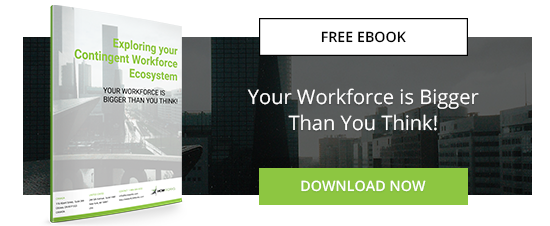If you use a contingent workforce, you understand the advantages that come with it: increased flexibility, bridging the skills gap, and turning fixed labor costs into variable costs to save money. However, you might not be so clear on the dangers that come with contingent labor management. These risks and liabilities can hurt your business—and your bottom line—so it’s important for you to be aware of them in order to ramp up your management efforts to mitigate them. This is especially true for organizations that use a large number of independent contractors, freelancers, consultants, and other non-permanent, temporary workers.
Here are just some of the dangers you face from being careless with contingent labor management.
Non-Compliance
One of the biggest risks from poor contingent labor management is non-compliance with government rules and regulations. Particularly, worker misclassification. It can be tricky to determine whether your workers are independent contractors or employees, and the way you manage them could put you in a gray area where you risk fines and penalties for misclassification.
You must treat your contingent workforce differently, even if treating them equally to your employees seems like a fairer, and simpler, way to go. When it comes to providing them tools and equipment, offering training and development, exercising financial or behavioral control and providing them with perks and benefits, you have to be careful.
If you get audited or a contractor files a lawsuit against you, the government might determine that you misclassified them when they should have been labeled as employees, and as such, should have been provided workers’ compensation, overtime, holiday pay, health coverage and benefits, unemployment insurance, and other perks. This mistake can be extremely costly—so classify carefully.
Payments
One of the biggest benefits of using contingent workers is that you can pay them through accounts payable rather than your payroll account, which means you reduce your costs, have a higher payroll budget, and don’t have to jump through so many bureaucratic hoops to pay them. Unfortunately, this can also cause confusion.
If your payroll process for contingent workers isn’t efficient and streamlined, you can quickly run into trouble. You could lose track of how many contingent workers you have on staff, which can make it difficult to budget payroll costs. You can also make errors more easily when every independent contractor is paid different rates and at different time periods. These errors can cost you. You need effective contingent labor management to ensure that you’re paying these workers promptly and accurately.
Poor Performance
Without effective contingent labor management, you won’t be able to track or measure performance, which can lead to reduced productivity. You could end up paying high prices for work that isn’t worth the cost, and not realize it until the work is done. Investing in contingent workforce software, on the other hand, can provide you with the real-time data and visibility into performance that you need to ensure optimal productivity and greater results from your contingent workers.
Sourcing Complexities
If you’re like many other business owners in the United States, you’re likely expecting to increase your use of contingent labor in the near future. But because sourcing these temporary workers doesn’t go through HR like typical recruiting and hiring, your sourcing needs might quickly move beyond your capabilities if you do not have a contingent labor management program in place. You might not have the metrics in place to ensure you’re getting the best value for your dollar. Automating the sourcing process can help you reduce your sourcing risks and ensure that you’re spending money on the best contingent workers for all of your projects.
Eliminate the Dangers of Inefficient Contingent Labor Management
When you invest in technology for the effective management of your contingent workforce, you can streamline your operations, which will reduce your risks of non-compliance, payroll-related issues, performance issues, and sourcing issues.



